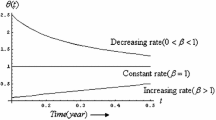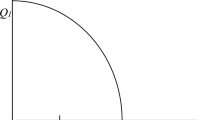Abstract
The proposed model represents the optimal time, EQO and optimal total cost, for two different time intervals as components of first run time under-considered constant demand, inventory is non-contact within the first component-time runs, constant within a second, purchasing cost is more than holding, the finite horizon planning, without shortage cost, replenishment required after the second component which is equal the first leading time of first run time. The inventory level is non-zero within a lengthier time on the horizon. Sensitivity analysis for the proposed model has represented the many values for varying demand; the deterioration rate lies in an assumed range. The represented figures explained the performance of optimal quantity and optimal total cost within the components of the first runtime (required time), the difference between the optimal total cost and the actual total cost was proposed.
Access this chapter
Tax calculation will be finalised at checkout
Purchases are for personal use only
Similar content being viewed by others
References
Abd PL (1996) Optimal pricing and lot sizing under conditions of perishability and partial back ordering. Manage Sci 42:1093–1104
Bierman H, Thomas J (1977) Inventory decisions under inflationary conditions. Decisions Sciences 23:553–558
Chern,M.S., Teng,J.T., Chan,Y.L., (1999) A compersion among various inventory shortage models for deteriorating items on the basis of maximizing profit. Asia-Pacific Journal of Operation Research 5:1176–1182
Dave U, Patel,L.K., (1981) Policy inventory model for deteriorating items with time proportional demand. J Oper Res Soc 32:137–142
Friedman,M.F., (1982) Inventory lot size models with general time dependent and carrying cost function. INFOR 20:157–167
Haneveld,K.W.K., Teunter,R.H., (1992) Effects of discounting and demand rate variability on the EOQ. International Journal of production economic 54:173–192
Misra,R.B., (1979) A note on optimal inventory management under inflation. Naval Research Logistics Quarterly 26:161–165
Padmanabhan G, Var P (1995) EOQ models for perishable items under stock dependent selling rate. Eur J Oper Res 86:281–292
Pal,.A.K.,Bhunia,.A.K.,Mukherjee,.R.N., (2005) A marketing oriented inventory model with three component demand rate dependent on displayed stock level. Journal of the Operational Research Society, 113–118
Rong,N.K., Mahapatra,N.K., Maiti,M., (2008) A two-warehouse inventory model for a deteriorating item with partially /fully backlogged shortage and fuzzy lead time. Eur J Oper Res 189:59–75
Sachan,R.S., (1984) Policy inventory model for deteriorating items with time proportional demand. J Oper Res Soc 35:1013–1019
Umap,H.P., (2014) Fuzzy Eoq Model for deteriorating items with exponential membership function. American Journal of Applied Mathematics and Statistics 2:203–206
Waliv,R.H., Umap,H.P., (2016) Fuzzy stochastic inventory model for deteriorating item. Yugoslav Journal of Operations Research 27:91–97
Mishra U, Waliv,R.H., Umap,H.P., (2019) Optimizing of multi-objective inventory model by different fuzzy techniques. International Journal of Applied and Computational Mathematics 5:136
Waliv RH.,Umap,.H.P., (2018) Multi item two-warehouse fuzzy inventory model. International Journal of Procurement Management (IJPM) 11, 443–454
Waliv,.R.H., Mishra,.U.,Garg,.H.,Umap,.H.P., (2020) A nonlinear programming approach to solve the stochastic multi-objective inventory model using the uncertain information. Arab J Sci Eng 45, 6963–6973
Acknowledgements
We would like to thank the editor and referees for the important comments and suggestions that improved the paper, the thanking to Thamar University in Yemen for financially supporting also SRTM University in India. This work is supported by the Mathematical School of Sciences, India to develop the inventory model of deteriorating items.
Author information
Authors and Affiliations
Editor information
Editors and Affiliations
Rights and permissions
Copyright information
© 2021 The Author(s), under exclusive license to Springer Nature Switzerland AG
About this paper
Cite this paper
Alshami, A., Muley, A. (2021). Optimal Time and EOQ for Inventory of Deteriorating Items with Variation and Leading Times. In: Pawar, P.M., Balasubramaniam, R., Ronge, B.P., Salunkhe, S.B., Vibhute, A.S., Melinamath, B. (eds) Techno-Societal 2020. Springer, Cham. https://doi.org/10.1007/978-3-030-69925-3_1
Download citation
DOI: https://doi.org/10.1007/978-3-030-69925-3_1
Published:
Publisher Name: Springer, Cham
Print ISBN: 978-3-030-69924-6
Online ISBN: 978-3-030-69925-3
eBook Packages: EngineeringEngineering (R0)




